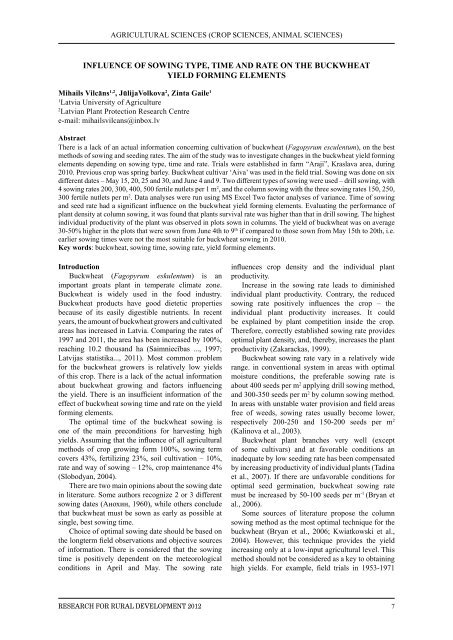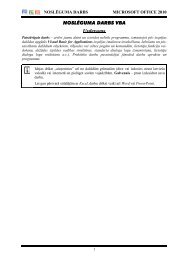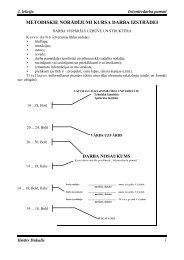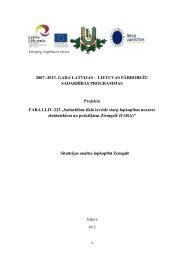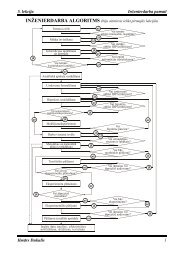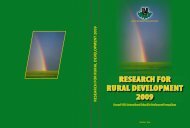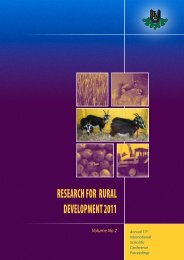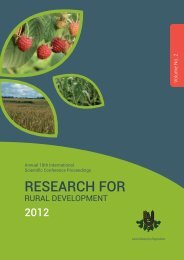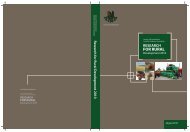AGRICULTURAL SCIENCES (CROP SCIENCES, ANIMAL SCIENCES)INFLUENCE <strong>OF</strong> SOWING TYPE, TIME AND RATE ON THE BUCKWHEATYIELD FORMING ELEMENTSMihails Vilcāns 1,2 , JūlijaVolkova 2 , Zinta Gaile 11Latvia University of Agriculture2Latvian Plant Protection Research Centree-mail: mihailsvilcans@inbox.lvAbstractThere is a lack of an actual information concerning cultivation of buckwheat (Fagopyrum esculentum), on the bestmethods of sowing and seeding rates. The aim of the study was to investigate changes in the buckwheat yield formingelements depending on sowing type, time and rate. Trials were established in farm “Araji”, Kraslava area, during2010. Previous crop was spring barley. Buckwheat cultivar ‘Aiva’ was used in the field trial. Sowing was done on sixdifferent dates – May 15, 20, 25 and 30, and June 4 and 9. Two different types of sowing were used – drill sowing, with4 sowing rates 200, 300, 400, 500 fertile nutlets per 1 m 2 , and the column sowing with the three sowing rates 150, 250,300 fertile nutlets per m 2 . Data analyses were run using MS Excel Two factor analyses of variance. Time of sowingand seed rate had a significant influence on the buckwheat yield forming elements. Evaluating the performance ofplant density at column sowing, it was found that plants survival rate was higher than that in drill sowing. The highestindividual productivity of the plant was observed in plots sown in columns. The yield of buckwheat was on average30-50% higher in the plots that were sown from June 4th to 9 th if compared to those sown from May 15th to 20th, i.e.earlier sowing times were not the most suitable for buckwheat sowing in 2010.Key words: buckwheat, sowing time, sowing rate, yield forming elements.IntroductionBuckwheat (Fagopyrum eskulentum) is animportant groats plant in temperate climate zone.Buckwheat is widely used in the food industry.Buckwheat products have good dietetic propertiesbecause of its easily digestible nutrients. In recentyears, the amount of buckwheat growers and cultivatedareas has increased in Latvia. Comparing the rates of1997 and 2011, the area has been increased by 100%,reaching 10.2 thousand ha (Saimniecības ..., 1997;<strong>Latvijas</strong> statistika..., 2011). Most common problemfor the buckwheat growers is relatively low yieldsof this crop. There is a lack of the actual informationabout buckwheat growing and factors influencingthe yield. There is an insufficient information of theeffect of buckwheat sowing time and rate on the yieldforming elements.The optimal time of the buckwheat sowing isone of the main preconditions for harvesting highyields. Assuming that the influence of all agriculturalmethods of crop growing form 100%, sowing termcovers 43%, fertilizing 23%, soil cultivation – 10%,rate and way of sowing – 12%, crop maintenance 4%(Slobodyan, 2004).There are two main opinions about the sowing datein literature. Some authors recognize 2 or 3 differentsowing dates (Анохин, 1960), while others concludethat buckwheat must be sown as early as possible atsingle, best sowing time.Choice of optimal sowing date should be based onthe longterm field observations and objective sourcesof information. There is considered that the sowingtime is positively dependent on the meteorologicalconditions in April and May. The sowing rateinfluences crop density and the individual plantproductivity.Increase in the sowing rate leads to diminishedindividual plant productivity. Contrary, the reducedsowing rate positively influences the crop – theindividual plant productivity increases. It couldbe explained by plant competition inside the crop.Therefore, correctly established sowing rate providesoptimal plant density, and, thereby, increases the plantproductivity (Zakarackas, 1999).Buckwheat sowing rate vary in a relatively widerange. in conventional system in areas with optimalmoisture conditions, the preferable sowing rate isabout 400 seeds per m 2 applying drill sowing method,and 300-350 seeds per m 2 by column sowing method.In areas with unstable water provision and field areasfree of weeds, sowing rates usually become lower,respectively 200-250 and 150-200 seeds per m 2(Kalinova et al., 2003).Buckwheat plant branches very well (exceptof some cultivars) and at favorable conditions aninadequate by low seeding rate has been compensatedby increasing productivity of individual plants (Tadinaet al., 2007). If there are unfavorable conditions foroptimal seed germination, buckwheat sowing ratemust be increased by 50-100 seeds per m -1 (Bryan etal., 2006).Some sources of literature propose the columnsowing method as the most optimal technique for thebuckwheat (Bryan et al., 2006; Kwiatkowski et al.,2004). However, this technique provides the yieldincreasing only at a low-input agricultural level. Thismethod should not be considered as a key to obtaininghigh yields. For example, field trials in 1953-1971Research for Rural Development 20127
INFLUENCE <strong>OF</strong> SOWING TYPE, TIME AND RATEON THE BUCKWHEAT YIELD FORMING ELEMENTSMihails Vilcāns, Jūlija Volkova, Zinta Gaileshowed that the average yield, using the columnsowing method was 1.32 t ha -1 , independently of theprevious crop, while obtained average yield, usingdrill sowing was 1.86 t ha -1 (Ефименко, Барабаш,1990)Some authors haveconcluded that all parametersof plant productivity were significantly higher whenthe column sowing method was used if compared withother sowing methods (Ефименко, 1990; Чашкова,2007). While different results have been publishedby V. Upmanis (1957). Observations during twoyears have showen that highest yields were obtainedby column sowing method, as recommended byД. Ефименко and И. Барашкин. The yield wasrespectively 1.97 t ha -1 when column sowing methodwas used, and 1.27 t ha -1 when drill sowing was used(Upmanis, 1957).The yield forming elements of buckwheat are:number of branches, number of inflorescences andnutlets per plant. Also plant height is an importantmorphological parameter. In the agro-climaticconditions of Latvia, data on the influence of sowingtype, time and rate on the yield forming elements arenot well documented.The aim of the current study was to investigate theinfluence of sowing date and rate in different sowingtypes on buckwheat yield forming elements. Partof the research about the buckwheat yield has beenalready described in 2011 (Vilcans et al., 2011).Materials and MethodsTwo-factor field trials (A factor – sowing date, Bfactor – sowing rate) were arranged in farm “Araji”,Kraslava region, (latitude: N 55º 86´; longitude: E 27º04´) in 2010. Buckwheat cultivar ‘Aiva’ was used andsown using two different sowing types, drill sowingand column sowing, on six different sowing dates.Factor – A sowing dates:1 st – called 15 th May,2 nd – called 20 th May,3 rd – called 25 th May,4 th – called 30 th May,5 th – called 4 th June,6 th – called 9 th June.Factor – B seeding rates:drill sowing – 200, 300, 400 and 500fertile nutlets per 1 m 2 ,Column sowing – 150, 250 and 300 fertilenutlets per 1 m 2 .The trial was randomly spaced; in total, 42 plotswerearranged in 4 replications. The plot size – 3 × 15m. Soil parameters - silt loam l (organic matter content22.5 g kg -1 , soil reaction pH KCl – 5.8, P – 74.23 mgkg -1 , K – 149.36 mg kg -1 . Previous crop was springbarley.Traditional soil tillage with 25 - cm - deepautumn plowing was done immediately after theharvesting of spring barley. Soil was cultivated threetimes before sowing in spring. One week before thesecond cultivation, weed treatment was done with theherbicide Roundup Eco s.c. (glyphosate, 360 g L -1 ).All nitrogen fertilizer was incorporated before sowingtogether with the soil cultivation. For compoundfertilizer NPK 16-16-16 with 200 kg ha -1 rate wasused N 32 kg ha -1 ; P – 14 kg ha -1 and K – 26 kg ha -1rate was used. Buckwheat was sown with mechanicalseed-rows-ploughshare 4-m-wide drill – NordsteinLiftomatik, with normal 12 – cm - width line-spacing.Variants sown in columns was composed of tworows with a distance between rows of 12 cm, but thatbetween the columns – 38 cm; depth of buckwheatsowing was 4 cm. The yield was harvested with agrain harvester Massey Ferguson 525, header width -3.5 m. The yield was accounted as 100% pure nutlets’yield at the moisture content of 140 g kg -1 .Buckwheat plant density was established bycounting the plants in one constant 0.5 m 2 area of eachplot after germination. Ten plant samples were takenrandomly from each plot for biometrical analysis atthe end of vegetation. Number of branches per plant(No), plant weight (g), stem length (cm), number ofinflorescences (No), and grain weight per plant (g)were measured in laboratory.Phenological observations during the growingseason:- the phenological phase starts when 10-15% ofthe plants have reached the development stage,the full phase means the time of 75% of theplants are in the phase.- the beginning of the phase and full phase wasrecorded: first seedling phase, flowering phase,technical maturity (ripe nutlets from 70 to75%), harvest maturity (ripe nutlets 90 - 95%).Two-factor analysis of variance, and correlationand regression analysis methods were used for dataprocessing. Meteorological data was obtained fromDaugavpils Hydro-meteorological Station (HMS)which is the nearest HMS to the farm. Meteorologicalconditions of the 2010 growing season can bedescribed as warm and wet with periodic substantialrainfall. When plants reached technical maturity phase(70 - 75% of brown nutlets on the plant), the weatherconditions of high temperature and extraordinary highamount of precipitations contributed to the restorationof plant growth, which extended the growing season,and made it difficult to choose an appropriate time forbuckwheat harvesting.Results and DiscussionPhenological observations. There was determineddependence of the length of developmental phases and8 Research for Rural Development 2012
- Page 1 and 2: Volume No. 1Annual 18th Internation
- Page 3 and 4: Research for Rural Development 2012
- Page 6 and 7: ContentsFOOD SCIENCESVETERINARYMEDI
- Page 10 and 11: Mihails Vilcāns, Jūlija Volkova,
- Page 12 and 13: Mihails Vilcāns, Jūlija Volkova,
- Page 14 and 15: AGRICULTURAL SCIENCES (CROP SCIENCE
- Page 16: Berit TeinEFFECT OF ORGANIC AND CON
- Page 19 and 20: AGRICULTURAL SCIENCES (CROP SCIENCE
- Page 21 and 22: Methane producing bacteria use only
- Page 23 and 24: according to calculations the metha
- Page 25 and 26: AGRICULTURAL SCIENCES (CROP SCIENCE
- Page 27 and 28: CHANGES IN SUGAR CONTENT OF WINTERO
- Page 29 and 30: CHANGES IN SUGAR CONTENT OF WINTERO
- Page 31 and 32: CHANGES IN SUGAR CONTENT OF WINTERO
- Page 33 and 34: PERENNIAL GRASSES FOR BIOENERGY PRO
- Page 35 and 36: PERENNIAL GRASSES FOR BIOENERGY PRO
- Page 37 and 38: PERENNIAL GRASSES FOR BIOENERGY PRO
- Page 39 and 40: AGRICULTURAL SCIENCES (CROP SCIENCE
- Page 41 and 42: IMPACT OF SLURRY APPLICATION METHOD
- Page 43 and 44: IMPACT OF SLURRY APPLICATION METHOD
- Page 45 and 46: AGRICULTURAL SCIENCES (CROP SCIENCE
- Page 47 and 48: IMPACT OF ORGANIC PRODUCT EXTRACTS
- Page 49 and 50: IMPACT OF ORGANIC PRODUCT EXTRACTS
- Page 51 and 52: AGRICULTURAL SCIENCES (CROP SCIENCE
- Page 53 and 54: COMBUSTION ABILITY OF ENERGY CROP P
- Page 55 and 56: COMBUSTION ABILITY OF ENERGY CROP P
- Page 57 and 58: AGRICULTURAL SCIENCES (CROP SCIENCE
- Page 59 and 60:
RESEARCH OF OREGANO (ORIGANUMVULGAR
- Page 61 and 62:
RESEARCH OF OREGANO (ORIGANUMVULGAR
- Page 63 and 64:
INFLUENCE OF SOIL MODIFICATION ON C
- Page 65 and 66:
INFLUENCE OF SOIL MODIFICATION ON C
- Page 67 and 68:
INFLUENCE OF SOIL MODIFICATION ON C
- Page 69 and 70:
INCIDENCE OF POSTHARVEST ROT OF CRA
- Page 71 and 72:
INCIDENCE OF POSTHARVEST ROT OF CRA
- Page 73 and 74:
AGRICULTURAL SCIENCES (CROP SCIENCE
- Page 75 and 76:
PERSPECTIVES ON TRUFFLE CULTIVATION
- Page 77 and 78:
PERSPECTIVES ON TRUFFLE CULTIVATION
- Page 79 and 80:
PERSPECTIVES ON TRUFFLE CULTIVATION
- Page 81 and 82:
FACTORS AFFECTING GOAT MILK YIELDAN
- Page 83 and 84:
FACTORS AFFECTING GOAT MILK YIELDAN
- Page 85 and 86:
FACTORS AFFECTING GOAT MILK YIELDAN
- Page 87 and 88:
MILK UREA CONTENT AS INDICATOR FEED
- Page 89 and 90:
MILK UREA CONTENT AS INDICATOR FEED
- Page 91 and 92:
MILK UREA CONTENT AS INDICATOR FEED
- Page 93 and 94:
REHYDRATION KINETICS OF DRIED LATVI
- Page 95 and 96:
REHYDRATION KINETICS OF DRIED LATVI
- Page 97 and 98:
REHYDRATION KINETICS OF DRIED LATVI
- Page 99 and 100:
FOOD SCIENCESPreliminary RESULTS of
- Page 101 and 102:
PRELIMINARY RESULTS OF 1-METHYLCYCL
- Page 103 and 104:
FOOD SCIENCESSensory PROPERTIES and
- Page 105 and 106:
SENSORY PROPERTIES AND CHEMICAL COM
- Page 107 and 108:
SENSORY PROPERTIES AND CHEMICAL COM
- Page 109 and 110:
SENSORY PROPERTIES AND CHEMICAL COM
- Page 111 and 112:
THE SUITABILITY OF DIFFERENT ROWANB
- Page 113 and 114:
THE SUITABILITY OF DIFFERENT ROWANB
- Page 115 and 116:
THE SUITABILITY OF DIFFERENT ROWANB
- Page 117 and 118:
THE SUITABILITY OF DIFFERENT ROWANB
- Page 119 and 120:
CHEMICAL COMPOSITION OF NEW TYPE AG
- Page 121 and 122:
CHEMICAL COMPOSITION OF NEW TYPE AG
- Page 123 and 124:
CHEMICAL COMPOSITION OF NEW TYPE AG
- Page 125 and 126:
FOOD SCIENCESINFLUENCE OF GENOTYPE
- Page 127 and 128:
INFLUENCE OF GENOTYPE AND HARVEST T
- Page 129 and 130:
INFLUENCE OF GENOTYPE AND HARVEST T
- Page 131 and 132:
INFLUENCE OF GENOTYPE AND HARVEST T
- Page 133 and 134:
ROOT VEGETABLES FROM LATVIA:QUANTIT
- Page 135 and 136:
ROOT VEGETABLES FROM LATVIA:QUANTIT
- Page 137 and 138:
ROOT VEGETABLES FROM LATVIA:QUANTIT
- Page 139 and 140:
CONTENT OF SUGARS, DIETARY FIBRE AN
- Page 141 and 142:
CONTENT OF SUGARS, DIETARY FIBRE AN
- Page 143 and 144:
CONTENT OF SUGARS, DIETARY FIBRE AN
- Page 145 and 146:
RHEOLOGICAL PROPERTIES OF TRITICALE
- Page 147 and 148:
RHEOLOGICAL PROPERTIES OF TRITICALE
- Page 149 and 150:
RHEOLOGICAL PROPERTIES OF TRITICALE
- Page 151 and 152:
acceptance and preference especiall
- Page 153 and 154:
CONSUMERS’ ATTITUDE TOWARDS AVAIL
- Page 155 and 156:
CONSUMERS’ ATTITUDE TOWARDS AVAIL
- Page 157 and 158:
PHYSICAL - CHEMICAL CHARACTERIZATIO
- Page 159 and 160:
PHYSICAL - CHEMICAL CHARACTERIZATIO
- Page 161 and 162:
FOOD SCIENCESTHE INFLUENCE OF DIFFE
- Page 163 and 164:
THE INFLUENCE OF DIFFERENT SELENIUM
- Page 165 and 166:
FOOD SCIENCESINVESTIGATIONS INTO TH
- Page 167 and 168:
INVESTIGATIONS INTO THE ENHANCEMENT
- Page 169 and 170:
INVESTIGATIONS INTO THE ENHANCEMENT
- Page 171 and 172:
INVESTIGATIONS INTO THE ENHANCEMENT
- Page 173 and 174:
INFLUENCE OF PACKAGING CONDITIONSON
- Page 175 and 176:
INFLUENCE OF PACKAGING CONDITIONSON
- Page 177 and 178:
FOOD SCIENCESFATTY ACID COMPOSITION
- Page 179 and 180:
FATTY ACID COMPOSITION OF THE MEAT
- Page 181 and 182:
FATTY ACID COMPOSITION OF THE MEAT
- Page 183 and 184:
ANTIMICROBIAL RESISTANCE OFANIMAL P
- Page 185 and 186:
ANTIMICROBIAL RESISTANCE OFANIMAL P
- Page 187 and 188:
ANTIMICROBIAL RESISTANCE OFANIMAL P
- Page 189 and 190:
VETERINARY MEDICINETHE SURVIVAL OF
- Page 191 and 192:
THE SURVIVAL OF LISTERIA MONOCYTOGE
- Page 193 and 194:
THE SURVIVAL OF LISTERIA MONOCYTOGE
- Page 195 and 196:
THE SURVIVAL OF LISTERIA MONOCYTOGE
- Page 197 and 198:
VETERINARY MEDICINEMicrobiological
- Page 199 and 200:
MICROBIOLOGICAL QUALITY OF COWS’
- Page 201 and 202:
MICROBIOLOGICAL QUALITY OF COWS’
- Page 203 and 204:
MICROBIOLOGICAL QUALITY OF COWS’
- Page 205 and 206:
PORCINE CIRCOVIRUS-2 IMPACT ON THEM
- Page 207 and 208:
PORCINE CIRCOVIRUS-2 IMPACT ON THEM
- Page 209 and 210:
PORCINE CIRCOVIRUS-2 IMPACT ON THEM
- Page 211 and 212:
PORCINE CIRCOVIRUS-2 IMPACT ON THEM
- Page 213 and 214:
AORTIC LUMEN DIAMETER AND BLOODPRES
- Page 215 and 216:
AORTIC LUMEN DIAMETER AND BLOODPRES
- Page 217 and 218:
AORTIC LUMEN DIAMETER AND BLOODPRES
- Page 219 and 220:
PHYSICAL MODEL OF TRACTOR IMPLEMENT
- Page 221 and 222:
PHYSICAL MODEL OF TRACTOR IMPLEMENT
- Page 223 and 224:
PHYSICAL MODEL OF TRACTOR IMPLEMENT
- Page 225 and 226:
SOLID FUEL BOILER AUTOMATION FOR BR
- Page 227 and 228:
SOLID FUEL BOILER AUTOMATION FOR BR
- Page 229 and 230:
SOLID FUEL BOILER AUTOMATION FOR BR
- Page 231 and 232:
INVESTMENT COSTS OPTIMIZATION OFMUL
- Page 233 and 234:
INVESTMENT COSTS OPTIMIZATION OFMUL
- Page 235 and 236:
DYNAMIC MODEL OF BIOCHEMICAL NETWOR
- Page 237 and 238:
DYNAMIC MODEL OF BIOCHEMICAL NETWOR
- Page 239 and 240:
EDUCATIONAL SCIENCESCHILDREN WITH S
- Page 241 and 242:
CHILDREN WITH SPECIAL NEEDS FAMILY
- Page 243 and 244:
CHILDREN WITH SPECIAL NEEDS FAMILY
- Page 245:
CHILDREN WITH SPECIAL NEEDS FAMILY


